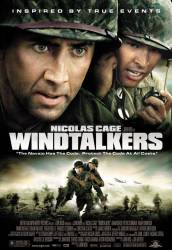Visible crew/equipment: When Nicholas Cage goes and throws the satchel charge into the Japanese bunker, as he turns to run his helmet falls off and you can plainly see that it is not Cage but his stunt double.
Visible crew/equipment: In the final battle scene in which the heavy Japanese artillery is firing down on the column of U.S. Marines, One rather large Japanese shell explodes next to a tank and engulfs the tank commander in flames. You can clearly see the silver fire-retardant suit the stunt man is wearing.
Visible crew/equipment: In the scene (chapter 16) where Joe and Ben are riding on the back of a truck up a dirt road, there is a shot where Joe and Ben are leaping off the back of the truck after it was hit. You can see the shadow of the overhead camera very clearly in the bottom right hand corner. (01:04:22)






Answer: The point of using the Navajo code to call in air strikes was to encrypt what the Marines were requesting without the Japanese being able to decipher what was said. This is critical because during the Battle of Saipan, the Japanese made extensive use of caves and reinforced earthworks to support their artillery positions and machine gun nests. The delay between requesting artillery support and the act of carrying it out allowed the Japanese to withdraw their infantry to relative safety before the fire mission could commence. By using PVT Yahzee and PVT Whitehouse, they were able to circumvent this and request attacks without the Japanese knowing what was coming. The only time Yahzee does not use the code is when he uses the Japanese radio to call off the artillery strikes that were falling short and hitting Marines. This situation required immediate attention and it would not have been appropriate to use the code.
Invader_Gir